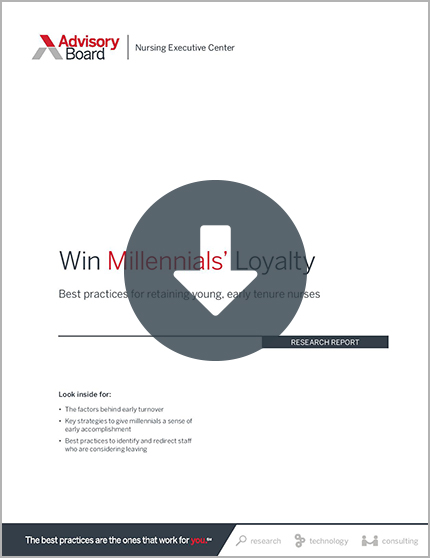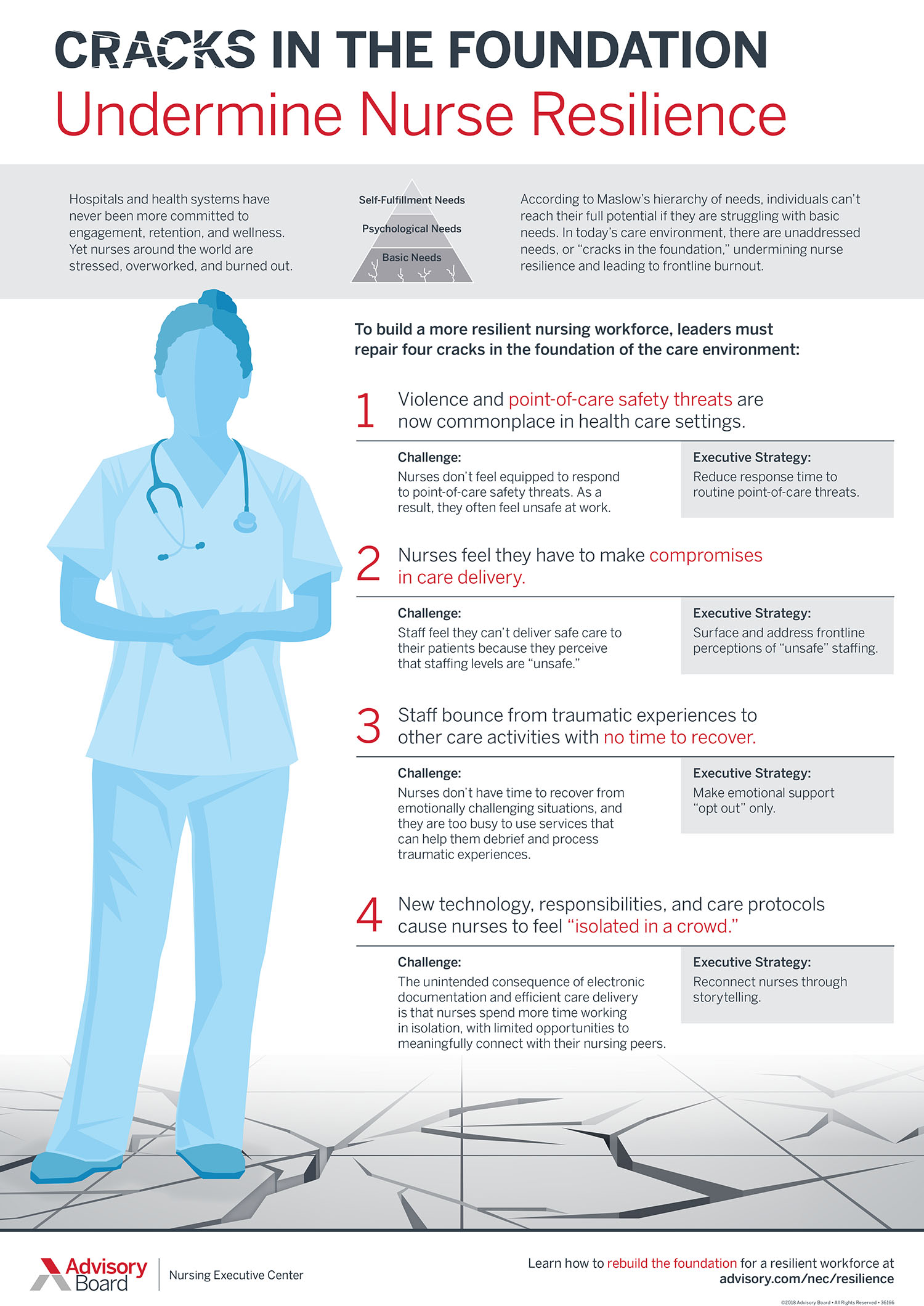Auto logout in seconds.
Continue LogoutEditor's note: This popular story from the Daily Briefing's archives was republished on Nov. 6, 2019.
By Jackie Kimmell, Senior Analyst
Part seven in a series of the seven conversations all managers should be having with their employees
You suspect some of your employees are thinking about retirement. You understand a few might plan on leaving in the next few years. But you might not realize just how many.
According to a 2017 survey of more than 3,300 registered nurses, 27% of nurses are planning on retiring in less than a year, up from 16% who said the same in 2015. Much of the increase is driven by baby boomers reaching retirement age: 73% of baby boomer nurses plan to retire in the next 3 years, according to the same survey.
The trend is playing out with physicians too, who in addition to reaching retirement age, are reporting record levels of frustration with their jobs. In a recent survey, 48% of doctors reported planning to cut their hours, retire, or leave their clinical practice due to dissatisfaction with recent changes in health care.
To make matters worse, even a few retirements can spark a "domino effect" of mass retirements, leading to a downward spiral in morale, an erosion of the workplace culture, and even more retirements.
So what can your organization do to prepare for these retiring baby boomers and prevent a chain of more people leaving?
Advisory Board HR Advancement Center's Kate Vonderhaar suggests a solution: offer phased retirement options to give high-value staff a way to leave more gradually—keeping their institutional wisdom on board through trying times.
HR leaders, make sure to look at Advisory Board's Retirement Risk Appraisal tool, which helps you evaluate retirement risk for different teams and craft retention plans for critical employees.
The benefits of a delayed retirement strategy
"Retirements are inevitable. You're not going to stop people from retiring," Vonderhaar said. "However, what you are trying to stop is the chaos of having everyone retire at the same time."
When many people leave at the same time, "not only do you have to find people to fill these roles, but you also end up with a huge knowledge gap," according to Vonderhaar. "It's a big hit to the team when you have people who have built up all of this great knowledge leave the team at once."
Creating a phased retirement strategy, Vonderhaar said, not only prevents the chaos of a mass exodus, but it also has subtler benefits:
- Encouraging staff to more slowly retire can give your HR department more time to find great new candidates; and
- It can boost employee engagement. These conversations are about letting staff know how much you value their contributions and want those contributions to continue—an uplifting and engaging message.
Three delayed retirement strategies you can try
One of the most important components of a phased retirement strategy is offering employees flexibility to meet their personal needs. There are three tactics to consider:
- A formalized phased retirement plan
A formalized phased retirement option offers the employee a chance to work reduced hours in the same role and with a prorated salary. One four-hospital system on the West Coast has crafted a formalized plan that allows employees to work 24 hours per pay period, receive full benefits, and access money in their retirement account if needed. (A quick caveat: Laws governing pensions and defined contribution plans are subject to change and varying interpretation, so we recommend leaders consult with legal counsel before redesigning retirement plans.)
The program has been popular at the system. While they are selective about choosing which high-performing employees are eligible for participation, more than 120 people are in the program at any given time. On average, participants spend about 2.48 years in the program before fully retiring.
- Dedicated project time
Because late-career employees may struggle to keep up with the demands of direct patient care, some organizations let these employees spend some of their time on less physically demanding work, which can extend their careers while retaining their valuable bedside experience.
The Ontario Ministry of Health, for example, created a program called the "Late Career Nursing Initiative" that invites nurses over age 55 to shift about 20% of their time to completing a high-value project.
Under the program, nurses typically dedicate one full day a week to projects, which prevents the need to shift tasks around on other days. Some examples of projects that have been approved to bring value to the organization include a new patient care manual about post-anesthesia recovery, a new skin-preparation protocol, and designing a new nurse liaison role for pre-op orthopedic patients.
- Late career role changes
For many staff, even completing 80% of their current responsibilities can be too physically demanding. To help, progressive organizations actively help these staff make a late-career role change.
One large health system in Pennsylvania sends a monthly newsletter to all frontline nurses highlighting job openings across the system. This helps inform and motivate staff who may otherwise not know what roles are available, and it reduces onboarding costs by allowing positions to be filled internally.
Organizations can do even more by working with department leaders to develop a list of potential alternative roles for late-career employees. Managers can then use this list to start structured conversations with employees about alternative careers.
For 13 examples of roles well-suited for late-career nurses, including job descriptions and requirements, view our Late-Career Role Change Guide on page 34 of Navigating Looming Mass Retirements of Frontline Staff.
To learn more phased retirement strategies, as well concrete tactics to help retiring staff transfer institutional knowledge, be sure to download the HR Advancement Center's whole study on Navigating Looming Mass Retirements of Frontline Staff
This concludes our series of the seven conversations all managers should have with their employees. Missed one of them? Read them all at the links below.
- You're hiring the wrong employees. Here's how to find the right ones.
- Have a new hire? This is the first meeting you should schedule.
- The 3 reasons your new hires keep leaving—and how to retain them.
- Your employees need regular recognition to stay engaged. Here are 3 ways to make it a habit.
- The right way to set your team's goals (and 1,000 health care-specific goals to get you started)
Don't miss out on the latest Advisory Board insights
Create your free account to access 1 resource, including the latest research and webinars.
Want access without creating an account?
You have 1 free members-only resource remaining this month.
1 free members-only resources remaining
1 free members-only resources remaining
You've reached your limit of free insights
Become a member to access all of Advisory Board's resources, events, and experts
Never miss out on the latest innovative health care content tailored to you.
Benefits include:
You've reached your limit of free insights
Become a member to access all of Advisory Board's resources, events, and experts
Never miss out on the latest innovative health care content tailored to you.
Benefits include:
This content is available through your Curated Research partnership with Advisory Board. Click on ‘view this resource’ to read the full piece
Email ask@advisory.com to learn more
Click on ‘Become a Member’ to learn about the benefits of a Full-Access partnership with Advisory Board
Never miss out on the latest innovative health care content tailored to you.
Benefits Include:
This is for members only. Learn more.
Click on ‘Become a Member’ to learn about the benefits of a Full-Access partnership with Advisory Board
Never miss out on the latest innovative health care content tailored to you.


